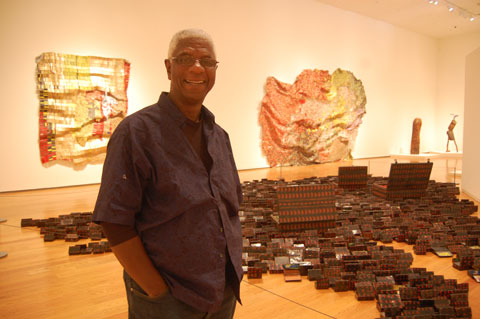
CULTURAL FUSION El Anatsui describes himself as the product of two traditions, “the Western one, which I acquired in art school, and the African one, which I started acquiring on my own.” |
It was around 1999 when El Anatsui found a bag of milk-tin lids, and then a bag of bottle caps. The Ghanaian artist had come to believe in mining his materials directly from his environment as a way of making art that his fellow Africans would understand, as well as a way of projecting Africa out to the rest of the world.The bags of junk sat around in his studio for some time before he hit on the idea of wiring together the lids and flattened bottle caps into metal tapestries. The bottle-cap patterns recalled traditional kente cloth; the recycled metal glittered like gold.
El Anatsui had been on the international scene for decades, including an appearance in the 1990 Venice Biennale. But these monumental bottle-cap curtains — exhibited in the solo survey "Gawu" and the group show "Africa Remix," both of which toured Europe and the US from 2004 to '07, and then again in the 2007 Venice Biennale — have made him the pre-eminent artist working in Africa today. At least as far as the West is concerned. But there's no need for geographical qualifications: El Anatsui is one of the most exciting artists at work anywhere.
>> Photo Slideshow: 'El Anatsui: When I Last Wrote to You about Africa'
at the Davis Museum <<
So the US premiere — at Wellesley College's Davis Museum — of the El Anatsui retrospective "When I Last Wrote to You About Africa," which was organized for New York's Museum of African Art by Lisa Binder, is not just one of the best shows you'll see this year but a landmark.
El Anatsui (his art name; he keeps the name his parents gave him to himself) was born in 1944, the youngest of 32 siblings, in the Ewe town of Anyako, Ghana. People there were occupied with fishing, salt harvesting, and, during the off-season, weaving — a craft his father and some brothers did in their spare time.
"I'm a product of two different traditions," El Anatsui tells me, "the Western one, which I acquired in art school, and the African one, which I started acquiring on my own."
After Ghana gained independence from the British, in 1957, it experienced a heady period of pan-African optimism and calls for re-engagement with and elevation of African traditions. Then in the late '60s, the country was racked by military coups and economic collapses — like many other newly independent African nations. But at that time, the Ghanaian colleges where El Anatsui studied art still followed a British-style curriculum, focusing on Western art techniques and history. "There was no exposure to one's own traditions."
So he began to do his own research, studying the old African ways at cultural centers and directly from artisans. His first works here are wooden plates — the sort usually used to display fruit and vegetables in markets — that he commissioned from village craftsmen between 1973 and '75. With heated metal rods and knives, he burned traditional designs (a leafy shape with spikes at each end signifying the omnipotence of God) and his own inventions (a tangle of footprints for a piece titled On Their Fateful Journey Nowhere) into their centers.